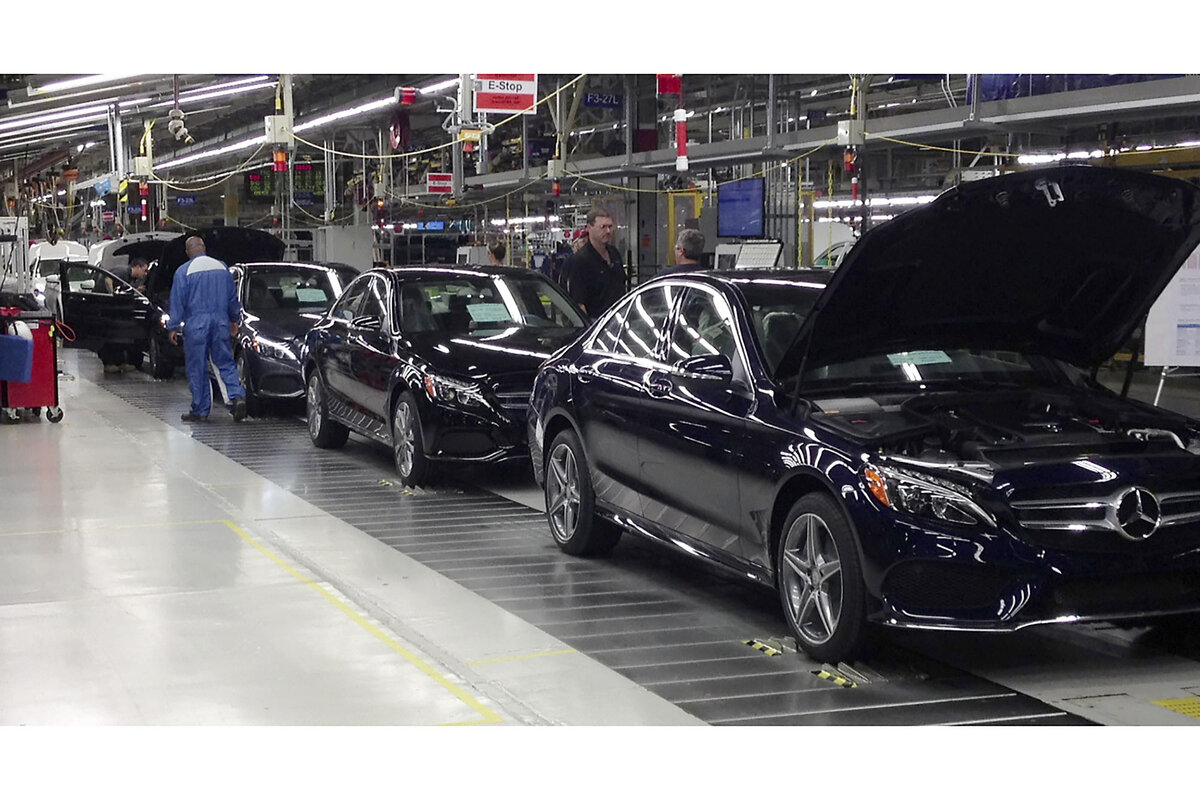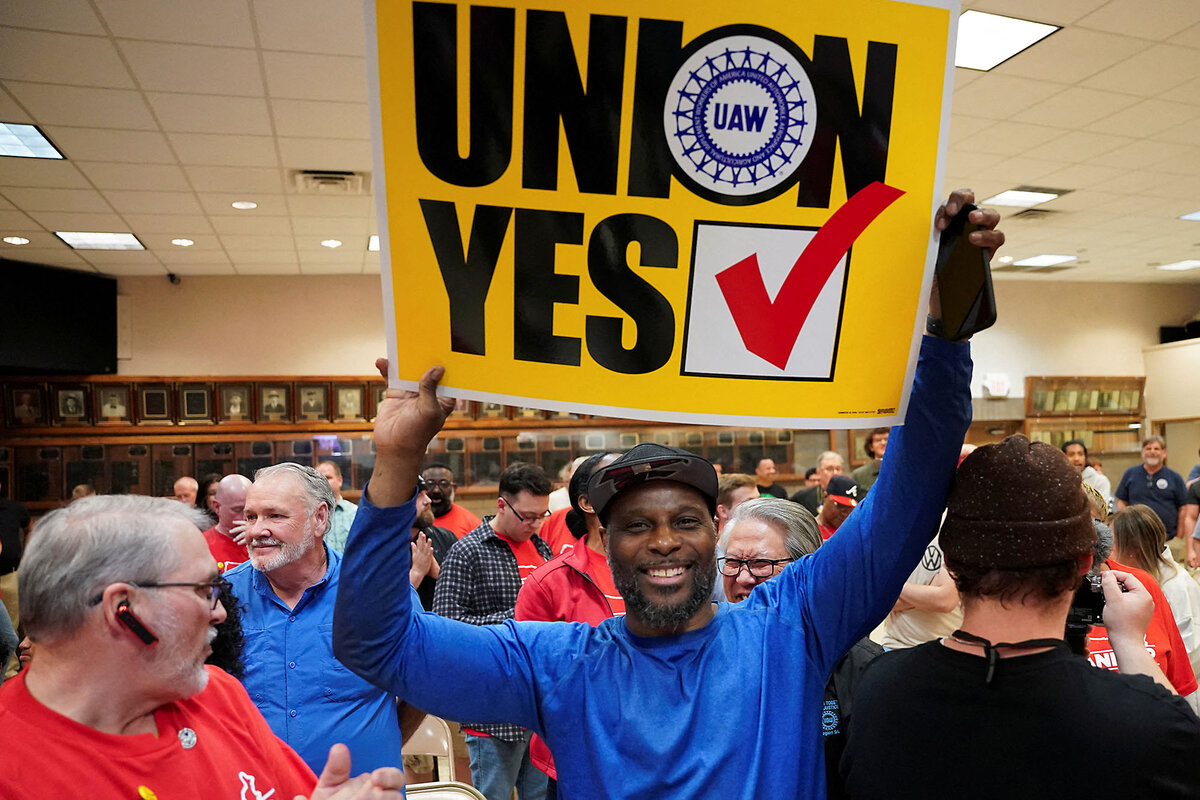With vote at Alabama plant, UAW challenges South’s antiunion tilt
Loading...
| Vance, Ala.
The first time Rob Lett saw a worker wearing a red union hat at his sprawling Mercedes plant, he thought, “Wow, that takes courage.”
His second thought: “Why doesn’t he get fired?”
Unions have long found the American South to be hostile territory. But Mercedes workers here in central Alabama now hold organized labor’s hopes for this critical region in the palms of their hands.
Why We Wrote This
A story focused onIf Mercedes employees in Alabama vote this week to join the United Auto Workers, it may signal an important shift in America’s most union-resistant region.
If the Mercedes workers vote this week to allow the United Auto Workers to represent them, they will become the second foreign-owned auto plant in the South to unionize, giving the UAW important momentum. If they vote no, they will add to a long line of failed efforts to organize America’s most union-resistant region. The voting began on Monday and continues through Friday.
“A lot here is going to depend on the vision of unionism that the United Auto Workers can put forward,” says Rick Halpern, professor of history and director of American studies at the University of Toronto. If the vote is just about wages and benefits, its impact is limited, he says. “But if there’s a larger vision about democracy in the United States, and about transforming the way in which capitalism is operating and making it more equitable, then I think we may be seeing something very, very powerful.”
A stretch of highway that tells a story
Such a shift would be an uphill battle here in the South, due to cultural, racial, economic, and political factors that stretch back to the Civil War. A half-hour stretch of Interstate 20 illustrates the challenge.
A few miles west of this Mercedes plant, in Brookwood, Alabama, lies the headquarters of Warrior Met Coal. For two years, plant employees who were members of the United Mine Workers stayed off the job, pressuring management for a new contract. Last year, the union called off the strike without winning any concessions – an ignominious defeat.
Less than 30 miles to the east, in Bessemer, workers at a local Amazon fulfillment center still don’t know if they’ve officially joined a union, even after two years and two votes. A judge has just started a monthslong process to sort it out.
Here in Vance, by contrast, spirits are running high. Last fall, new union leadership pulled off a stunning victory at Detroit’s big automakers, securing the best new contract in decades. General Motors, Ford, and Stellantis (Chrysler’s parent company) agreed to a pay raise of at least 25% over four years, the phasing out of a lower pay scale for some workers, and the reinstatement of automatic cost-of-living increases.
“The strike in the fall was the first time the UAW was able to show workers in these plants in the South that they could deliver,” says Stephen Silvia, a political scientist at American University and author of “The UAW’s Southern Gamble: Organizing Workers at Foreign-Owned Vehicle Plants.”
Workers in the South take notice
Last month, Volkswagen employees in Chattanooga, Tennessee, became the first workers to ratify a union at a southern auto plant not owned by one of the Detroit carmakers – a historic win. Earlier in May, UAW members approved a new, higher-wage contract at Daimler Truck, a heavy-truck unit of the same company that owns Mercedes, with six facilities in the South. Now, Mercedes workers here in Vance are voting on whether to follow in Volkswagen’s footsteps. It will be a tougher challenge.
At Volkswagen, the Germany-based management – under pressure from its German workers – agreed to stay neutral in the Chattanooga ratification vote. By contrast, the Mercedes-Benz Group has taken a more traditional, antiunion approach. On the plant fence, management put up a banner urging workers to vote in the ratification election. On the other side, it read, “Vote No.”
Managers have held mandatory worker meetings explaining why they should vote against the UAW. Workers say the company has hired an antiunion consulting firm that helped Amazon push back against the union in Bessemer.
Unions threaten economic model
Political opposition to organized labor also remains potent in the South, particularly in states with Republican governors. In South Carolina, where German automaker BMW has a plant that’s a likely UAW target, Gov. Henry McMaster (R) said in a January speech that he would fight unions “to the gates of hell.” Alabama Gov. Kay Ivey (R) has called the effort at Mercedes an “attack” on the state’s economic model.
Unionization does, in fact, threaten the South’s longtime economic model. Ever since the late 19th century, when textile mills moved down from New England to escape demanding unions, leaders here in Alabama have promised factory owners low-priced land and labor. Even after slavery’s end, the region continued its reliance on oppressed labor – sharecroppers, tenant farmers, and people who had been convicted of crimes.
“There’s a long tradition there of unfree labor,” says Robert Korstad, emeritus professor of public policy at Duke University and author of a 2003 book on Southern tobacco workers’ struggle to unionize.
Economically, the pitch worked. Attracted by cheap land and low labor rates, waves of outside industries set up shop, including Northern steel plants in the 1960s and 1970s and foreign-owned auto plants starting in the 1980s. Unions, which tend to raise wages and give workers more say, were not welcome in that economic model.
States competed to offer incentives to outside companies to relocate and collaborated to keep unions out. They passed “right-to-work” laws, so workers wouldn’t have to pay union dues even if their plant were organized. Antiunion politics that started as a Southern Democratic strategy to keep African Americans from organizing among themselves and with poor white Americans morphed into a Southern Republican laissez-faire movement.
Individual over collective action
Culturally, too, the South has long prized individual over collective action. Even many blue-collar workers are suspicious of the organizing efforts. Such efforts in South Carolina have failed at Boeing and, more recently, at a nuclear fuels plant.
“I am very against unions,” says Howard Gilmore, manager for a local logistics contractor that supplies the Mercedes plant. If his shop were unionized, he says, he would have trouble firing people who refused to do their work. Already, workers job-hop from plant to plant, he adds, taking advantage of hiring bonuses and leaving when the work gets too onerous.
But the lure of a contract with big pay raises may prove even more decisive for many Mercedes workers voting on unionization this week. What’s different now is a “sense of disaffection and resentment,” says Mr. Lett, the plant worker. “It has a whole different fire about it. Before, it was just an idea. Now it’s become something tangible.”
Mainly, workers here complain that a tiered system pits some employees against others. Temporary workers get up to $10 an hour less for doing the same tasks as full-time workers. Employees also say they have seen their benefits lag.
Some workers also question the region’s lower-wage economic model, which Mercedes worker Jeremy Kimbrell calls the “Alabama discount.”
Demographics add their own twist. The South skews younger than the rest of the U.S., and younger workers are more often open to considering union membership. An influx of workers from other states – and other nations – has also made the region’s politics less conservative.
“I think the conditions [for unions] in the South now in 2024 are better than they have been in decades, probably better than they’ve ever been,” says Georgetown University historian James Benton.
Patrik Jonsson reported from Vance, Alabama. Laurent Belsie reported from Waltham, Massachusetts.







